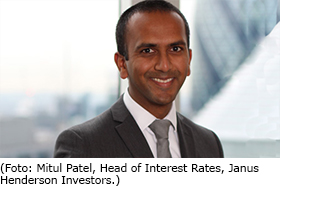
Janus Henderson: Rates in 2018 — Japan could disrupt markets
2018 is likely to see further tightening from central banks, though the focus is likely to shift from the US Federal Reserve towards the European Central Bank and potentially the Bank of Japan.
23.11.2017 | 12:30 Uhr
 What lessons have you learned from 2017?
What lessons have you learned from 2017?
2017 finally saw a move to tightening by several central banks, which allowed us to see what happens when central banks tighten policy. Ultimately, tightening passed without much incident, despite fears that after almost a decade since prior hiking cycles concluded, the withdrawal of liquidity would expose fragilities in markets. Risk assets performed better than I expected and volatility measures remain exceptionally low across a range of markets, suggesting that interest rate hikes can be weathered with a greater resilience as we go into 2018.
What are the key themes likely to shape the markets in which you invest in 2018 and how is this likely to impact portfolio positioning?
Markets will have to withstand a further reduction in government bond purchases from central banks, although European yields may not rise as much as forecasters believe, as negative overnight interest rates are likely to provide a strong anchor for government bonds of all maturities.
Though less likely, any shift in Bank of Japan policy could be more disruptive for global fixed income markets, given that current policy targets ‘yields’ rather than quantity of purchases, and the size of capital outflows from Japan in recent years. The Federal Reserve is likely to continue raising rates cautiously, while the Bank of England faces the difficult task of setting monetary policy through the Brexit negotiations. Ultimately, low macroeconomic volatility is likely to weigh on government bond volatility and government bond yields are likely to remain relatively range-bound.
Where do you currently see the risks within your asset class and where are the most compelling opportunities?
The economic recovery in Europe is likely to lead to a repricing in European fixed income markets, as currently investors are too cautious about holding bonds of longer maturities given the reduction in European Central Bank asset purchases, while remaining too complacent on the prospect for interest rate hikes in the coming few years. As such, I believe the yield differential between short-dated yields and long-dated yields is likely to compress significantly.
Current valuations already price in similar terminal interest rates in Europe and the US, while the market prices in fewer interest rate hikes from the European Central Bank over the next five years, than the following five. As a result, interest rate hikes are likely to be pulled forward and European yield curves are likely to flatten.



Diesen Beitrag teilen: